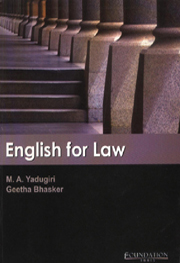Book contents
- Frontmatter
- Preface
- Contents
- A Note to the Student
- Notes to the Teacher
- 1 Nature of Law
- 2 Crimes and Civil Wrongs
- 3 Command of Language in the Profession of the Law
- 4 Plain Language and the Law
- 5 The Indian Constitution
- 6 The Impact of Technology on the Practice of Law
- 7 The International Court of Justice
- 8 Application of Precedents
- 9 Statutory Interpretation
- 10 Legal Reasoning
- 11 Plaints and Writs
- 12 Judgment
- 13 Of Defamation
- 14 Consumer Protection (Amendment) Act, 1993
- 15 The Information Technology Act, 2000
- 16 Universal Declaration of Human Rights
- Answer Key
8 - Application of Precedents
Published online by Cambridge University Press: 26 October 2011
- Frontmatter
- Preface
- Contents
- A Note to the Student
- Notes to the Teacher
- 1 Nature of Law
- 2 Crimes and Civil Wrongs
- 3 Command of Language in the Profession of the Law
- 4 Plain Language and the Law
- 5 The Indian Constitution
- 6 The Impact of Technology on the Practice of Law
- 7 The International Court of Justice
- 8 Application of Precedents
- 9 Statutory Interpretation
- 10 Legal Reasoning
- 11 Plaints and Writs
- 12 Judgment
- 13 Of Defamation
- 14 Consumer Protection (Amendment) Act, 1993
- 15 The Information Technology Act, 2000
- 16 Universal Declaration of Human Rights
- Answer Key
Summary
Aprecedent influences future decisions. Every decision is pronounced on a specific set of past facts and from the decision on those facts a rule has to be extracted and projected into the future. No one can foresee the precise situations that will arise, so the rule has to be capable of applying to a range of broadly similar situations against a background of changing conditions. It has therefore to be in general terms and ‘malleable’. As pointed out at the beginning, no word has one proper meaning, nor can anyone seek to fix the meaning of words for others, so the interpretation of the rule remains flexible and open-ended.
Applying a precedent to the instant case is a process of matching the fact-pattern of the precedent and the rule thereon with the fact-pattern of the instant case; if they match, the rule is applied, if not, it is distinguished. This involves two kinds of knowledge namely, knowing the facts and knowing the law applicable to those facts.
Knowing the facts
Knowing the facts of the instant case involves an exercise of discretion. This lies initially in believing or disbelieving the testimony of witnesses and weighing it on a balance of probability. Judges are human, so the quirks of individual personalities may also play some part occasionally.
- Type
- Chapter
- Information
- English for Law , pp. 245 - 282Publisher: Foundation BooksPrint publication year: 2005

